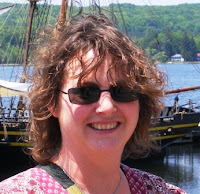Welcome to Route 1812 ~ Pathways to Peace ~ Western Corridor War of 1812-1814 website at www.westerncorridor1812.com
Pathways to Peace ~ Western
Corridor War of 1812-1814
Adrienne Horne,
M.A., Regional Project Manager, Western Corridor War of 1812 Bicentennial Alliance
ROUTE 1812 CONCEPT
…
Adrienne Horne, M.A.,
Regional Project Manager, Western Corridor War of 1812 Bicentennial Alliance
gave us some history-background of the initial concept Route 1812
Program
Dave Westhouse (A London Re-enactor from the Upper Canada Military
Re-enactment Society) presented this trail idea to the Western Corridor
Alliance in the early fall of 2010. Dave suggested that we start by plotting
out where the trail would be, on a map, and then identify the 1812 sites along
its route. After that is done we can identify sites within a specific distance
on either side of the trail that may garner further public interest and go on
from there. He figured that this project could be quite huge and garner a lot
of attention from every community it passes through and beyond.
I then learned that prior
to this, Ian Bell had tabled
this idea, called it Brock’s Walk, and it was to go from Fort York, through
Hamilton, Brantford and then down to Port Dover.
Then
I spoke with Zig Misiak from Brantford, and he too had the same idea
as Ian, recreate the route Brock took from Fort York to Amherstberg to join
forces with Tecumseh and capture Fort Detroit.
Where Dave, from London, had the path going from the
Tecumseh Monument to Dundurn Castle, and both Ian and Zig suggested a route
from Toronto to Amherstberg, I knew I had something. These 3 men had
independently proposed essentially the same idea but for different areas,
throughout Southern Ontario. The WCA
Steering Committee supported this project concept and I was instructed to set
up a committee of partners to flush out the route and sites to list.
As
I have talked about Ms. Horne in the past, she is a very creative, knowledgeable
and passionate person when it comes to “History”! I wasn’t surprised to see
how much Adrienne was a contributor to this Route 1812 project, but,
it did want to ask her how long she has been involved with
Route 1812 and how did she get involved?
Ms. Adrienne tells
us ... I became involved with this project from its becoming
committee work in September of 2010; just prior to that Dave Westbrook was
working with the London Heritage Council to see where the idea could go. As the
proposed
trail was to go through the WCA, I was charged with its organization.
I
thought our readers would be interested to learn from Adrienne, what was the
philosophy and thought process of the decisions in respect to the concepts,
activities, themes, events for Route 1812?
Adrienne
Horne replies … The concept was to research, plot and refine the main trails that would
have been used 200 years ago and identify War of 1812 sites of significance to
mark along the way. It was a way to allow each community along the route to
participate in telling their own stories from the War of 1812. We allowed them
to tell us what was going to go on the route and looked to them to provide the
stories.
This must has taken a lot of planning, so just how
far in advance did the work begin?
Adrienne tells me … Planning sessions began in the late fall of 2010 and
wrapped up in the spring of 2012. That is a lot of dedication and passion to keep
that much concentrated effort and Ontario
Visited applauds the hard work of all involved in the Route 1812 Project. Stay
tuned for more exciting news information about the planning of Route
1812. Stay tuned for more with Adrienne Horne, ROUTE 1812 & MORE!



